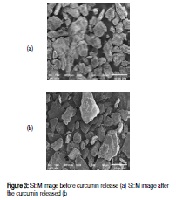Glutaraldehyde-Crosslinked Chitosan-Pectin Nanoparticles as a Potential Carrier for Curcumin Delivery and Its In Vitro Release Study
Keywords:
nanoparticles, curcumin, glutaraldehyde-crosslinked, chitosan-pectin, kinetic studyAbstract
Curcumin or diferuloylmethane as a naturally derived substance from herbal remedy and a good potential to posses many diseases are widely reported. However, Curcumin's poor aqueous solubility, low bioavalaibilty, and rapid degradation limiting clinical applicability. Nanoparticle encapsulation solves this problem and enables extended topical delivery of curcumin. There were several in vitro and invivo study of curcumin encapsulation, but different nano carriers were used for curcumin delivery, such as palmitat, formaldehyde, sodium tripolyphosphate and genipin croslinkings. Using a Glutaraldehyde-crosslinked chitosan-pectin nanoparticle for curcumin encapsulation to Increase the curcumin bioavailability in vitro was firstly described. The prepared nanoparticles were characterized by fourier transform infrared spectroscopy (FTIR), Transmission electron micrographs (TEM), Scanning electron microscopy (SEM) and X-ray diffraction (XRD). In vitro released kinetics study was adapted from Korsmeyer-peppas model. FTIR spectra revealed that nanoparticles were formed due to interaction between the carboxyl group of pectin and the prototonated amino groups of chitosan. Characterization of encapsulated curcumin using TEM was showed spherical morphology with size in around ± 40 nm. SEM revealed that no morphology changed between nanoparticles before and after the curcumin release, however the element composition of nanoparticles release has changed. Moreover, XRD analysis revealed the amorphous nature of the encapsulated curcumin. It was influenced by the concentration of polymer matrixs and glutaraldehyde. In vitro released kinetics study showed that the curcumin release from nanoparticle system tend to follow Korsmeyer-peppas model which had initial burst release followed by a steady state release. The release of curcumin was influenced by the concentration of polymer matrixs and glutaraldehyde. The present study concluded that glutaraldehyde-crosslinked chitosanpectin nanoparticles are promising carrier for effective delivery of curcumin. Thus, curcumin as a potential drug to cure many diseases could be explored effectively for clinical applicability.
References
. Anand, P., Kunnumakkara, AB, Newman, RA., Aggarwal, BB. Bioavailability of Curcumin: Problems and Promises. Mol Pharm 2007;6: 807-8.
. Shishodia, S, Chaturvedi, MM, Aggarwal, BB. Role of Curcumin in Cancer Therapy. Curr Probl Cancer 2007;31:243-305.
. Mohanraj, VJ and Chen, Y. Nanoparticles – A Review. Trop J Pharma Res 2006; 5:561-573.
. Liu, J, Xu, L, Liu, C, Zhang, D, Wang, S, Deng, Z, Lou, W, Xu, H, Bai, Q, Ma, J. Preparation and Characterization of Cationic Curcumin Nanoparticles for Improvement of Cellular Uptake. Carbohydr Polym 2012;90:16-22.
. Dutta, PK, Dutta, J, Tripathi, VS. Chitin and Chitosan: Chemistry, Properties and Applications. J Sci Ind Res 2004;63: 20-31.
. Ilium, L, Farraj, NF, Davis, SS. Chitosan as Novel Nasal Delivery System for Peptides Drugs. Pharm Res 1994;11: 1186-9.
. Morris, GA, Kok, MS, Harding, SE and Adam, GA. Polysaccharide Drug Delivery Systems Based on Pectin and Chitosan. Biotechnol Genet Eng Rev 2010;27:257-284.
. Chandur, VK, Badiger, AM, Shambashiva, RKRS. Characterizing Formulations Containing Derivatized Chitosan With Polymer Blending. Int J Res Pharm Chem 2011; 4(1): 950-967.
. Gupta, KC and Jabrail, FH. Glutaraldehyde and Glyoxal Cross-Linked Chitosan Microspheres for Controlled Delivery of Centchroman. Carbohydr Res 2006; 341:744–756.
. Anitha, A, Deepagan, VG, Rani, D, Menon, D, Nair, SV, Jayakumar, R. Preparation, Characterization, in Vitro Drug Release and Biological Studies of Curcumin Loaded Dextran Sulphate–Chitosan Nanoparticles. Carbohydr Polym 2011;84;1158–1164.
. Luppi, B, Zecchi, V, Bigucci, F, Abruzzo, A, Corace, G, Teresa Cerchiara, T. Freeze-Dried Chitosan/ Pectin Nasal Inserts for Antipsychotic Drug Delivery. Eur J Pharm Biopharm 2010;75:381–7.
. Mishra, RK, Banthia, AK, and Majeed, A. Pectin Based Formulations for Biomedical Applications: a review. Asian J Pharm Clin Res 2012;5:1-7.
. Dash, S, Murthy, PD, Nath, L, Chowdhury, P. Kinetic Modeling on Drug Release from Controlled Drug Delivery Systems. Acta Poloniae Pharm Drug Res 2010;3(67):217-223.
. Ravi, PR, Ganga, S, Saha, RN. Design and Study of Lamivudine Oral Controlled Release Tablets. AAPS Pharm Sci Tech 2007;4(8):1-9.
. Li, J, Feng, L, Fan, L, Zha, Y, Guo, L, Zhang, Q, Chen, J, Phang, Z, Wang, Y, Jiang, X, Yang, VC, Wen, L. (2011). Targeting the brain with PEG-PLGA nanoparticles modified with phage-displayed peptides. Biomaterials 32: 4943–50.
. Siepmann, J, Peppas, NA. Higuchi equation: Derivation, Applications, Use and Misuse. Int J Pharm 2011; 418: 6– 12.
. Siepmann, J, Peppas, NA. Modeling of Drug Release from Delivery Systems Based on Hydroxypropyl Methylcellulose (HPMC). Adv Drug Deliv Rev 2012;64: 163–174.
. Goel, A, Kunnumakkara, AB, Aggarwal, BB. 2008. Curcumin as “Curecumin”: from kitchen to clinic. Biochem. Pharmacol. 2008;75:787–809.
Shaikha, J, Ankolab, DD, Beniwal, V, Singha, D, Ravi Kumarb, MNV. Nanoparticle encapsulation improves oral bioavailability of curcumin by at least 9-fold when compared to curcumin administered with piperine as absorption enhancer. Eur J Pharm Sci 2009:37: 223–230.
.Sahu, A, Bora, U, Kasoju, N, Goswami, P. Synthesis of novel biodegradable and self-assembling methoxy poly(ethylene glycol)–palmitate nanocarrier for curcumin delivery to cancer cells. Acta Biomater 2008;4:1752–1761.
. Krausz, AE, Adler, BL, Cabral, V, Navati, M, Doerner, J, Charafeddine, RA, Chandra, D, Liang, H, Gunther, L, Clendaniel, A, Harper, S, Friedman, JM, Nosanchuk,JD, Friedman, AJ. Curcumin-encapsulated nanoparticles as innovative antimicrobial and wound healing agent. Nanomedicine: NBM 2015;11:195–206.
.Tahtat, D, Mahlous, M, Benamer,S, Khodjaa, AN, Oussedik-Oumehdi, H, Laraba-Djebarib, F. Oral delivery of insulin from alginate/chitosan crosslinked by Glutaraldehyde. In J Biol Macromol 2013;58:160– 168.





